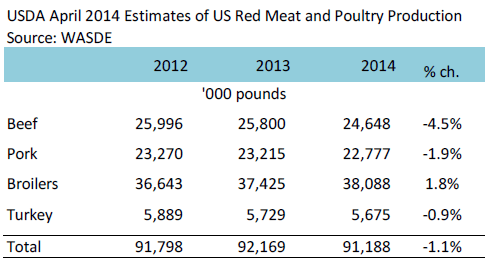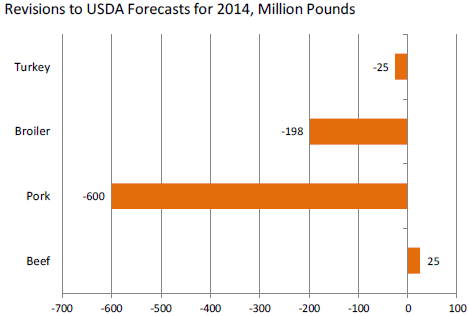In the case of grains, the report was viewed as relatively bullish, with USDA making significant changes to closely watched demand numbers. As for the revisions to meat forecasts, they were for the most part expected and current output estimates (and the resulting per capita consumption) still are far short of the extremely bullish assumptions built in the livestock market. Below are some highlights from the report:
Grains: USDA revised its corn balance sheet to account for a stronger export pace in both corn and beans. Corn use for the marketing year is now pegged at 13.450 billion bushels, up 125 million bushels from the previous estimate.
The change was entirely driven by estimates for larger corn exports. Indeed, at 1.750 billion bushels, US corn exports are now forecast to be 140 per cent larger than a year ago. Feed use was left unchanged but it bears repeating that at 5.3 billion bushels it is up 22.3 per cent higher than a year ago.
It is interesting that the feed demand estimate has remained unchanged in recent reports even as USDA has been steadily reducing its estimates of US pork and broiler production. At this point US estimates of beef, pork and poultry production are for a net 1.1 per cent decline and yet feed consumption is up by almost 1 billion bushels.
Soybean stocks were revised lower even as USDA added 30 million bushels of soybean imports to the balance sheet. Old crop bean supplies are expected to be extremely tight given current export pace. Soybean meal domestic disappearance is currently estimated to be up just 0.5 per cent, which is more in line with the current projected pork and poultry output.
Red meat and poultry: The following table presents the latest USDA output forecasts for 2014. As expected, USDA revised lower its estimates for pork production in 2014 based on the data from the 1 March Hogs and Pigs survey. Despite dire predictions about the impact of PEDv on US pork production, USDA at this point predicts pork supplies to decline 1.9 per cent from a year ago.

While we do not know the exact assumptions as to hog slaughter and weights, the reduction likely reflects a 5-6 per cent decline in slaughter for Q2 and Q3 as well and a modest decline in pork supply for Q4. This kind of slaughter reduction and the resulting pork output certainly is lower than what current hog futures are trading, even after the recent selloff.
USDA revised lower its estimates of US pork exports, which are now forecast to be down 2.8 per cent compared to a year ago. The downward revision reflects the modelled response of the lower supply availability in Q2 and Q3. At this point this remains a key wild card for the pork market. Other markets are also struggling with PEDv (Korea, Taiwan, Mexico) , which would be supportive of US pork exports. Still, the sharp spike in pork prices should have some impact on the quantity demanded from export markets this spring and summer.
Beef supplies were revised modestly higher, in part because of higher output during March and the accelerated rate of placements in the last couple of months. Current beef production is forecast to decline 4.5 per cent from a year ago compared to a decline of about 6 per cent that was forecast back in December. USDA made a significant upward revision to its beef import estimate (40 MM pounds) and US beef imports are now forecast to be up 3.3 per cent from a year ago. We suspect that number will be revised up again in the next couple of months given the pace of shipments to the US from key suppliers such as Australia, NZ and Canada.
Broiler supply growth was trimmed back given the current trend in chick placements and the slower than expected growth in the hatchery flock.






